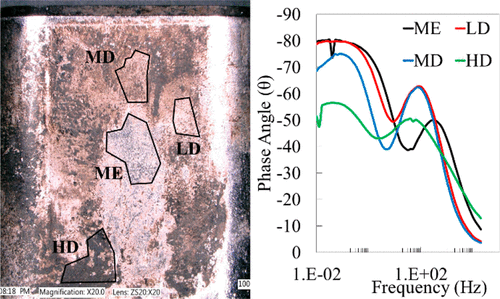当前位置:
X-MOL 学术
›
ACS Biomater. Sci. Eng.
›
论文详情
Our official English website, www.x-mol.net, welcomes your
feedback! (Note: you will need to create a separate account there.)
Sensing Localized Surface Corrosion Damage of CoCrMo Alloys and Modular Tapers of Total Hip Retrievals Using Nearfield Electrochemical Impedance Spectroscopy
ACS Biomaterials Science & Engineering ( IF 5.4 ) Pub Date : 2020-01-31 , DOI: 10.1021/acsbiomaterials.9b00945 Michael J. Wiegand 1, 2 , Aarti A. Shenoy 1, 2 , Sara E. Littlejohn 1 , Jeremy L. Gilbert 1, 2
ACS Biomaterials Science & Engineering ( IF 5.4 ) Pub Date : 2020-01-31 , DOI: 10.1021/acsbiomaterials.9b00945 Michael J. Wiegand 1, 2 , Aarti A. Shenoy 1, 2 , Sara E. Littlejohn 1 , Jeremy L. Gilbert 1, 2
Affiliation

|
Wear and corrosion damage of biomedical alloys alters the structure and electrochemical properties of the surface heterogeneously. It was hypothesized that local regions on the same surface systematically differ from one another in terms of their impedance characteristics. To test this hypothesis, CoCrMo disks exposed to electrosurgical and inflammatory-species-driven damage were characterized using a localized impedance technique, nearfield electrochemical impedance spectroscopy (NEIS), to assess point-specific surface integrity in response to applied damage. It was found that electrosurgical damage, as may arise during primary arthroplasty and revision surgeries, and hydrogen peroxide concentrations of 5–10 mM significantly alter the corrosion susceptibility of the local surface compared to the as-polished CoCrMo surface. A CoCrMo retrieved neck taper (Goldberg score of 4) was scored in different local regions on the basis of visual appearance, and it was found that there is a direct relationship between increasing debris coverage and decreasing impedance, with the global surface impedance closest to the most severely scored local region. This noninvasive method, which uses a millielectrode configuration to test localized regions, can measure the heterogeneous electrochemical impedance of an implant surface and be tailored to assess specific damage and corrosion mechanisms revealed on retrieval surfaces.
中文翻译:

使用近场电化学阻抗光谱技术检测CoCrMo合金的局部表面腐蚀损伤和全部髋臼的模块化锥度
生物医学合金的磨损和腐蚀损坏会异质地改变表面的结构和电化学性能。假设相同表面上的局部区域在阻抗特性方面系统地彼此不同。为了验证这一假设,使用局部阻抗技术(近场电化学阻抗谱(NEIS))对暴露于电外科和炎性物种驱动的损伤的CoCrMo圆盘进行了表征,以评估特定损伤后表面的特定点表面完整性。研究发现,与刚打磨的CoCrMo表面相比,电外科手术的损伤(如在初次关节置换和翻修手术中可能发生的)和5-10 mM的过氧化氢浓度会显着改变局部表面的腐蚀敏感性。根据视觉外观在不同的局部区域对CoCrMo回收的颈部锥度(Goldberg评分为4)进行评分,发现碎屑覆盖率增加与阻抗降低之间存在直接关系,整体表面阻抗最接近得分最高的地方。这种使用微电极配置来测试局部区域的非侵入性方法,可以测量植入物表面的异质电化学阻抗,并可以进行定制以评估在修复表面发现的特定损伤和腐蚀机制。整体表面阻抗最接近得分最高的局部区域。这种使用微电极配置来测试局部区域的非侵入性方法,可以测量植入物表面的异质电化学阻抗,并可以进行定制以评估在修复表面发现的特定损伤和腐蚀机制。整体表面阻抗最接近得分最高的局部区域。这种使用微电极配置来测试局部区域的非侵入性方法,可以测量植入物表面的异质电化学阻抗,并可以进行定制以评估在修复表面发现的特定损伤和腐蚀机制。
更新日期:2020-02-03
中文翻译:

使用近场电化学阻抗光谱技术检测CoCrMo合金的局部表面腐蚀损伤和全部髋臼的模块化锥度
生物医学合金的磨损和腐蚀损坏会异质地改变表面的结构和电化学性能。假设相同表面上的局部区域在阻抗特性方面系统地彼此不同。为了验证这一假设,使用局部阻抗技术(近场电化学阻抗谱(NEIS))对暴露于电外科和炎性物种驱动的损伤的CoCrMo圆盘进行了表征,以评估特定损伤后表面的特定点表面完整性。研究发现,与刚打磨的CoCrMo表面相比,电外科手术的损伤(如在初次关节置换和翻修手术中可能发生的)和5-10 mM的过氧化氢浓度会显着改变局部表面的腐蚀敏感性。根据视觉外观在不同的局部区域对CoCrMo回收的颈部锥度(Goldberg评分为4)进行评分,发现碎屑覆盖率增加与阻抗降低之间存在直接关系,整体表面阻抗最接近得分最高的地方。这种使用微电极配置来测试局部区域的非侵入性方法,可以测量植入物表面的异质电化学阻抗,并可以进行定制以评估在修复表面发现的特定损伤和腐蚀机制。整体表面阻抗最接近得分最高的局部区域。这种使用微电极配置来测试局部区域的非侵入性方法,可以测量植入物表面的异质电化学阻抗,并可以进行定制以评估在修复表面发现的特定损伤和腐蚀机制。整体表面阻抗最接近得分最高的局部区域。这种使用微电极配置来测试局部区域的非侵入性方法,可以测量植入物表面的异质电化学阻抗,并可以进行定制以评估在修复表面发现的特定损伤和腐蚀机制。











































 京公网安备 11010802027423号
京公网安备 11010802027423号